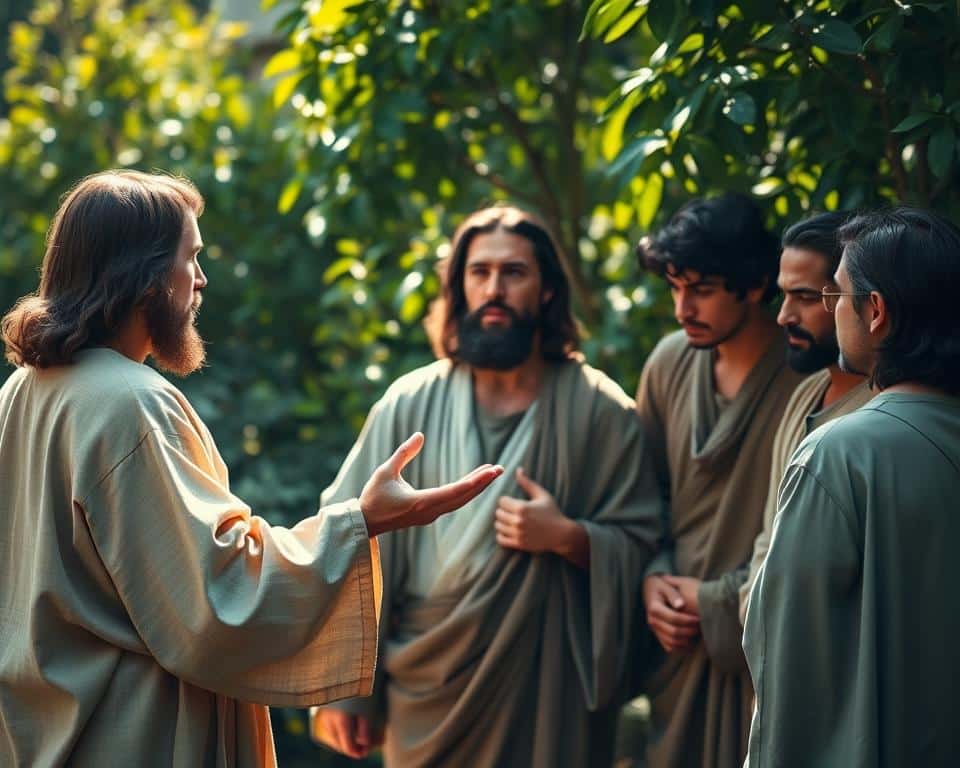Have you ever wondered what it truly means to follow a higher calling? In Mark 8:34, we find a powerful blueprint for living a life of purpose. It’s not just about belief—it’s about action. Denying yourself, taking up your cross, and following daily are the pillars of this journey.
This path isn’t easy, but it’s transformative. It’s about letting go of self-centered desires and embracing a mission greater than yourself. For believers, this is the essence of discipleship—a continuous commitment to faith and service.
Through this process, you gain a deeper understanding of life’s true purpose. It’s a paradox: by giving up, you receive. By losing yourself, you find meaning. This is the heart of what it means to be a disciple in the church and beyond.
Introduction to Jesus’ Teachings on Discipleship
What does it mean to live a life shaped by faith and purpose? Throughout the gospels, we see a clear message: true discipleship is about transformation. It’s not just hearing the word but letting it guide your actions. This journey begins with understanding the authority of the one who calls us.
As a rabbi, He used parables to reveal deep truths. Stories like the sower and the seed (Mark 4:13-34) show how the gospel takes root in our hearts. These lessons weren’t just for His time—they’re for us today. They challenge us to examine our priorities and align them with God’s kingdom.

His confrontations in the temple (Mark 7:1-23) highlight the importance of purity. He called out leaders who focused on tradition over truth. This reminds us that discipleship isn’t about outward appearances but a heart surrendered to God’s will.
His passion prophecies reveal the cost of following Him. He spoke openly about sacrifice and service. This isn’t just for the twelve disciples but for all who choose to walk this path. It’s a call to live differently, to put others first, and to trust in His plan.
Today, these teachings still guide us. They show how to live as faithful disciples in a world that often pulls us in other directions. By understanding His role as the Messiah, we can embrace a life of purpose and hope.
The Call to Discipleship
What does it truly mean to step into a life of faith and purpose? The call to discipleship is not just about belief—it’s about action. It’s a journey that requires denying oneself, taking up the cross, and following daily. This path challenges us to let go of self-centered desires and embrace a mission greater than ourselves.

Denying Oneself
Self-denial is more than giving up possessions. It’s about surrendering your identity and rejecting self-determination. In Mark 8:34, we see that this is the first step in discipleship. It’s a call to shift from self-preservation to kingdom priorities.
Peter’s denial in Mark 14:30-31 serves as a warning. Half-hearted commitment won’t sustain you on this journey. True discipleship requires a full surrender of your will to God’s plan.
Taking Up the Cross
Taking up the cross is both a literal and metaphorical act. It’s about being willing to face martyrdom for your faith. But it’s also about daily humility and sacrifice. Mark 15:21 reminds us that this is the essence of discipleship.
Marys and Salome modeled this persistent commitment. They stood by the cross, showing unwavering faith even in the hardest moments. Their example inspires us to live with the same dedication.
This is the way of discipleship—a life of obedience, sacrifice, and purpose. It’s not easy, but it’s transformative. By losing yourself, you find true meaning in life.
The Role of Obedience in Discipleship
How does obedience shape our faith journey? True obedience is more than following rules—it’s about aligning our lives with God’s word. In 1 John 2:3-6, we see that keeping His commandments is evidence of knowing Him. This isn’t about legalism but about a heart transformed by love.
Servant leadership, as shown in Mark 10:45, sets the example for us. Just as He came to serve, we are called to serve others. This responsibility reflects our commitment to His mission. It’s a call to live differently, putting others before ourselves.
Marriage teachings in Mark 10:7-9 highlight covenant obedience. It’s a reminder that faithfulness in relationships mirrors our faithfulness to God. This principle extends beyond marriage to every area of life.
In a culture focused on self-gratification, kingdom service stands in stark contrast. Ephesians 2:11-18 shows that obedience is for everyone, including Gentiles. It’s a call to unity and purpose, transcending cultural boundaries.
Obedience isn’t just a duty—it’s a response to God’s grace. It’s how we show our faith in action. By living in obedience, we honor Him and reflect His truth to the world.
Jesus’ Method of Making Disciples
How did Christ shape the lives of His closest followers? His approach was deeply personal and intentional. He spent 65-90% of His ministry time investing in a small group of individuals. This wasn’t about mass production but about personalized spiritual growth.
Intentional Relationships
Christ’s method centered on building strong relationships. He spent three years with the Twelve, sharing meals, traveling, and teaching. This life-on-life mentoring created a relational template for discipleship. He didn’t just preach; He lived alongside them.
For example, He used everyday moments like fishing trips and road teachings to impart wisdom. These experiences allowed His followers to see faith in action. It wasn’t just about knowledge but about transformation through shared experiences.
Formational Teaching
His teaching style was adaptable and focused on individual needs. He used parables, questions, and even challenges to guide His disciples. In Mark 4:35-41, He calmed a storm, turning a moment of fear into a lesson on faith.
This process wasn’t rushed. He took the time to address doubts, fears, and questions. His goal wasn’t just to create followers but to develop leaders who could carry on His mission. This approach shows us the importance of patience and intentionality in our own faith journeys.
The Mission of Discipleship
What does it mean to carry the gospel into the world? This question lies at the heart of discipleship. It’s not just about personal faith but about sharing hope with others. In Mark 8:35, we see that true discipleship involves proclaiming the gospel, even when it’s challenging.
Our mission is rooted in Genesis 1:26-28, where we’re called to reflect God’s image and restore His creation. This isn’t just about soul-winning; it’s about whole-life transformation. Discipleship impacts every area of our lives, from relationships to work.
Mark 9:38-41 reminds us that the kingdom is inclusive. It’s not about who gets the credit but about working together for God’s glory. This partnership extends beyond the church to all who seek truth.
Persecution is part of this journey. Mark 10:29-30 assures us that sacrifices made for the gospel will be rewarded. This isn’t a call to fear but to courage. It’s a reminder that our mission has eternal significance.
The Great Commission in Matthew 28:19 connects discipleship to everyday life. Whether at work, home, or in the community, we’re called to be witnesses. This is how we carry the gospel into the world—one step at a time.
Discipleship in the Early Church
How did the early church model discipleship for future generations? In the New Testament, we see a vibrant community of believers who turned their faith into action. Their example continues to inspire us today.
House churches became relational hubs for discipleship. These small gatherings allowed believers to grow in faith together. Acts 11:26 tells us it was in Antioch that the term “Christian” was first used, marking a new identity for followers of Christ.
The early church also navigated cultural differences. Acts 10 shows how Peter’s vision led to the inclusion of Gentiles. This was a pivotal moment, demonstrating that faith transcends cultural boundaries.
Leadership development was another key focus. In Antioch, leaders like Barnabas and Paul were set apart for mission work (Acts 13:1-3). This model of raising up leaders ensured the church’s growth and impact.
Epistles served as corrective tools for discipleship. Letters from Paul and others addressed challenges and encouraged believers to stay faithful. These writings remain relevant for us today.
Martyrdom was the ultimate test of obedience. Many early believers faced persecution, yet their unwavering faith inspired others. Their sacrifice reminds us of the cost of true discipleship.
Over the years, the early church’s example has shaped how we live out our faith. Their commitment to community, leadership, and obedience continues to guide us in our journey as disciples.
Modern Applications of Jesus’ Teachings on Discipleship
How can we apply timeless truths to our modern lives? The world has changed, but the core principles of faith remain the same. Today, we’re exploring how to live as disciples in a digital age, blending physical and virtual connections to deepen our walk with God.
Phygital Discipleship
Phygital discipleship combines physical and digital elements to create a hybrid model of ministry. This approach meets people where they are, whether in person or online. For example, many churches now host weekly Zoom meetings alongside monthly in-person services, as seen in Mark 9:41.
Accountability is key in this model. Small groups of 3-5 people foster deeper connections and mutual support. Tools like YouVersion Bible plans and Zoom prayer meetings make it easier to stay connected, even when life gets busy.
Post-COVID, many have shifted their approach to church attendance. Phygital ministry bridges the gap, offering flexibility without sacrificing community. One orthopedic surgeon shared how this model allowed him to stay engaged in his faith despite a demanding schedule.
This hybrid approach isn’t just a trend—it’s a way to reach more people with the gospel. By embracing technology, we can extend the reach of our ministry and impact the world in new ways.
Living as a Disciple of Jesus
What does it look like to live a life of faith in today’s world? It’s not about being extraordinary—it’s about being faithful in the everyday moments. Mark 10:29-30 reminds us that surrendering our lives brings hundredfold blessings. This promise is for everyone, not just a select few.
At work, your faith can shine through your actions. Whether you’re leading a team or completing tasks, let integrity and kindness guide you. Small acts of love can make a big impact. For example, offering encouragement or helping a colleague can reflect God’s character.
Family life also presents opportunities to live out your faith. Mark 10:7-9 teaches us about the importance of commitment and unity. In a world where relationships are often strained, choosing patience and forgiveness can strengthen your family bonds.
Another key to living faithfully is Sabbath-keeping. Taking time to rest and connect with God refreshes your heart and soul. It’s a rhythm that helps you stay grounded in your faith amidst life’s busyness.
Bobby Harrington’s story is a powerful example. He was a successful businessman who felt something was missing. When he encountered God’s word, his life transformed. Now, he helps others grow in their faith journey. His story shows that anyone can experience this change.
Living as a faithful follower isn’t about perfection—it’s about progress. Start where you are, and let God guide you step by step. Your everyday choices can reflect His love and bring hope to those around you.
Final Thoughts on Following Jesus
What does it mean to truly live as a follower of faith? Being a disciple is more than an activity—it’s an identity. It’s about aligning your life with God’s word and reflecting His love in everything you do.
Mark 8:36-37 warns against cultural Christianity, where faith becomes superficial. True discipleship requires a heart fully surrendered to God’s mission. It’s about using your gifts to make a kingdom impact, not just for personal gain.
There’s hope in the promise of Christ’s return. Romans 8:29 reminds us that our journey leads to glory. This hope anchors us, even in life’s challenges, and inspires us to live with purpose.
If you’re ready to begin this journey, take the first step today. Embrace the call to be a disciple and experience the transformative power of faith. Your story matters, and it’s never too late to start.





